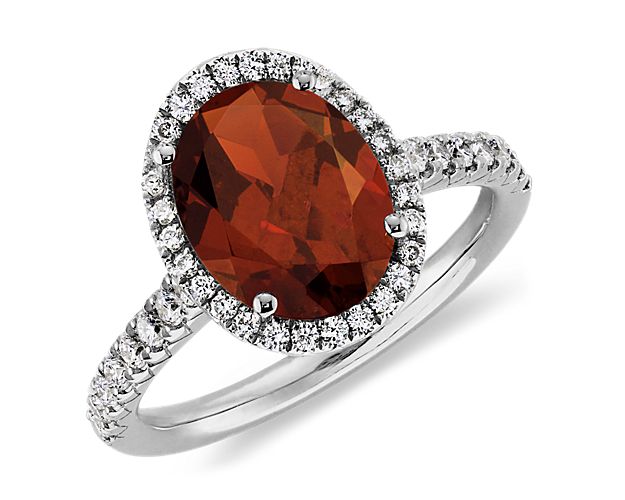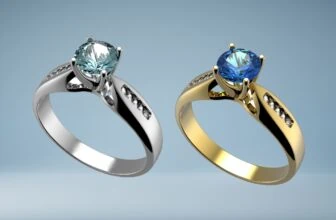
Table of Contents
Garnets are known as a popular ruby imitator, but they’re more than just that. These beautiful gemstones are gorgeous, stylish, and affordable. They have a darker hue than most rubies and are quite distinct in how they look. Let’s take a look at how to buy garnets, using the 4cs to choose garnet gemstones, types of garnets, and garnet jewelry.
What is a Garnet?
Understanding what a garnet is gets technical and complicated. For your reference, we have included a detailed section of garnet varieties at the end of this article.
Garnets are a species of gemstone. They’re not composed of a single mineral but is a group of closely related minerals that come in a variety of colors and chemical compositions. The name ‘garnet’ comes from an old Latin word granatum, which means dark red. Another connotation to the color red is that its granular form resembles the seeds of pomegranates.
For all January babies, garnets have a special connotation because it’s known as the January birthstone. It is believed to be one of the oldest gemstones and has been used for thousands of years.
How to Evaluate Your Garnet – 4Cs
As with any other gemstone, we use the famous 4Cs to evaluate the quality of garnets. The 4Cs stand for cut, color, clarity and carat weight.
1. Garnet Color

Garnet, often perceived merely as a deep red gemstone, truly spans a vibrant spectrum of colors. When evaluating the color of a garnet, one should consider three main components: hue, tone, and saturation. The hue refers to the dominant color of the garnet, which can range from the classic red to green, orange, and even rare blues. Tone, on the other hand, gauges how light or dark the color appears; a garnet can have a tone from light to medium to dark. Saturation speaks to the intensity of the color, with some garnets boasting vivid and rich hues while others might appear more muted or grayish.

Ideally, a high-quality garnet will have a well-balanced color that is neither too dark nor too pale, with a strong saturation that makes its hue pop. Of course, personal preferences play a pivotal role in choosing the ‘right’ color. Whether you’re drawn to the fiery oranges of spessartine garnets or the lush greens of tsavorite garnets, the key is to select a shade that resonates with your aesthetic and feels authentic to you.
2. Garnet Cut

The cut of garnet is important not only for its aesthetic appeal but also for its brilliance and durability. When evaluating the cut of this gemstone, one should focus on several key factors. Firstly, the proportions of the garnet are crucial. A well-proportioned cut ensures that light enters the stone and reflects back to the viewer’s eye optimally, giving the garnet its characteristic sparkle.
The symmetry of the facets, which are the flat surfaces cut into the gemstone, is another essential aspect. Asymmetrical or misaligned facets can disrupt the play of light within the stone, diminishing its brilliance. The depth of the cut is also crucial; a garnet that’s cut too shallow or too deep can appear lackluster, as light escapes from the sides or bottom rather than reflecting back.

Lastly, the finishing details, like the smoothness of the facets and the absence of visible imperfections on the surface, further determine the quality of the cut. A well-cut garnet will not only maximize the gemstone’s inherent beauty but also ensure its longevity, making it a cherished piece in any collection.
3. Garnet Clarity

Typically, garnets are known to be pristine gems, shining with clear transparency and a dazzling, glass-like sheen. Red garnets, especially the types called pyrope and almandine, stand out for their crystal-clear quality, usually free from noticeable flaws.

On the flip side, orange garnets, like spessartine and hessonite, tend to have more inclusions or internal marks. But here’s where gemology gets fascinating: these so-called “imperfections” can actually enhance the gem’s beauty. Some of these orange garnets possess an enchanting starry pattern, termed asterism.

It’s an intriguing twist in the gem world where what’s often seen as a defect transforms into a cherished rarity. This adds to the garnet’s allure, turning a seeming imperfection into a standout feature that’s highly desired.
4. Garnet Carat Weight

Garnets can be found in a diverse range of shapes and sizes. Some of the rarer kinds, like demantoid and tsavorite, are generally smaller. So, when their size (or carat weight) goes up, their value tends to skyrocket. On the other hand, more common types, like almandines, are often available in more generous sizes. It’s always fascinating how the rarity and size can play such a significant role in determining a gem’s value and appeal.
What about Treated Garnets?

Many gemstones on the market are treated in some way to enhance their appearance. Garnets, however, are not artificially treated or enhanced in any way. Yes, you read that right. Irradiation and heat treatment are not effective upon these gemstones. Garnets come in their natural colors so what you see is what you get with these stones.
You can find synthetic versions of garnets on the market but these are used in different ways. Here are two:
- Ytrrium Aluminium Garnet or YAG is a colorless simulant of diamonds which was popularly used until the 70’s when it lost its stake to Cubic Zirconia.
- Gadolinum Gallium Garnet or GGG – is produced for industrial purposes and rarely used as a gemstone.
Are Garnets Valuable?
Garnets can be quite valuable, though their worth varies significantly based on type, quality, size, and rarity. While some garnets, like the commonly found almandines, are relatively affordable, others, such as the rare demantoid and tsavorite varieties, can fetch high prices, especially in larger sizes or superior qualities. Factors like color, clarity, cut, and carat weight play vital roles in determining a garnet’s value.
Additionally, unique optical phenomena, like asterism or color change, can further enhance their worth. While garnets might not rival the exorbitant prices of diamonds or rubies, they certainly hold their own in the world of precious gemstones.
Garnet vs. Ruby: What’s the Difference?

The most common variety of garnets come in a deep red color that’s very similar to rubies. To the untrained eye, both gemstones look identical and it’s very difficult to tell them apart. Because garnets are not as valuable as rubies, some vendors can try to fob off a garnet for the price of a ruby.
Although at a glance rubies and garnets look very similar, there are ways to tell the two apart.
1. Examine the Color
Garnets cover a broad spectrum of colors, from red to brown, green, yellow, and even orange. The most common red garnets are almandine and pyrope, which usually have a warmer, brownish or purplish undertone. Rubies, on the other hand, are best known for their vibrant red hue. They generally have a more vivid, sometimes almost “glowing”, cooler undertone.
2. Hold It Against a Light Source
Hold up your stone against a bright light source and examine the spectrum. The spectrum is the rainbow created by moving the stone around.
Garnets will usually reflect bands of yellow and green; rubies will reflect blues and reds because they absorb the greens and yellows in the spectrum.
3. Observe the Refraction
If you examine the stone against a light source, look for double rainbows within the stone. Rubies are doubly refractive, which means a double rainbow image will appear.
Garnets, on the other hand, are singly refractive and the rainbow that will appear is clearer and less blurred than that of rubies.
4. Check for Hardness
A ruby has a high ranking of 9 on the Mohs scale, just below diamonds which rank supreme at 10. A garnet, on the other hand, is quite a soft stone and ranks at 6.5 to 7.5.
If the stone you’re holding scratches easily and by a substance of a hardness ranking below 9, then it is probably a garnet.
5. Seek Professional Advice
Rubies are right up there with diamonds, emeralds, and sapphires when it comes to precious gems. They’re usually pricier than garnets. If you’ve got one, it’s a good idea to check with a trusted jeweler and make sure it’s the real deal and worth the bucks.
Garnet Jewelry
With its striking sophistication and appealing price tags, garnets are an attractive gemstone for any form of jewelry.
Garnets are perfect for minimalist jewelry. For earrings, they can be worn as studs or delicate dangle earrings. A garnet tennis bracelet is a dainty and classy way to add a touch of color without going overboard and the same can be said for garnet pendants.

They also work as statement pieces. A garnet cocktail ring will surely steal the show with its blood red hue. For a striking effect, choose a garnet statement necklace for a bold and confident look.
Garnets pair best with silver colored metals, although yellow gold gives it a classic look. For a vintage style, opt for yellow gold garnet jewelry.

Red and pink don’t always complement each other, so you might think that red garnets set in rose gold wouldn’t look appealing. But this isn’t the case. Take a look at this rose gold garnet ring with pink tourmalines surrounding it. It has a vintage charm, bold color and simply looks stunning. Because rose gold tends to suit any skin tone, garnets set in rose gold are ideal for anyone.
Is a Garnet Engagement Ring a Good Idea?

While we love garnets here, we cannot really endorse it as a gemstone for an engagement ring. This is because the stone is quite soft and can easily be scratched and damaged.
For an engagement ring, you will need a gemstone that can be worn on a daily basis and can withstand the daily knocks of life that it is bound to come in contact with. If you are after a red stone, a ruby or synthetic red diamond will be among the most durable options. However, these are quite pricey in comparison to a garnet.
While garnets aren’t as hard as rubies, with consistent care and maintenance, you will be able to keep your garnet shining for a length of time. Some claim to have garnet rings that are centuries old. If required, you can replace the garnet on your ring at a lower price point than a ruby.
Garnet Varieties

Although they are most commonly known as red or burgundy stones, garnets actually come in a variety of chemical compositions. These can be confusing and complicated but bear with us!
There are six recognized species of garnet: pyrope, almandine, spessartite, grossularite, uvarovite, and andradite. On top of these, however, are eleven more garnet varieties based on color or other special properties!
- The garnets that have a distinctive red color and closely resemble rubies are of the pyrope These have a high refractive index which causes their impressive brilliance.
- The most popular garnets, however, are the almandine These come in pure red, reddish orange, and brownish red colors. While it looks very similar to pyrope, it is not as vivid. Interestingly, although it is one of the most common garnet varieties and there are huge amounts sourced all over the world, gem-quality stones have been rarely surfacing in the past decade.
- Another popular variety is grossularite. This type of garnet ranges in color from lemon yellow to greenish-yellow to mint green.
- The andradite variety is the most lustrous of all the garnets. It has three further varieties: the rare olive-green to emerald-green demantoid, the yellow to brownish-yellow topazolite, and the lustrous opaque black melanite, often simply known as the black garnet.
- There is also the uvarovite which is the only consistently green garnet. It has a deep emerald green color and is very rare making it very valuable.
- Spessartite is a rarer species of garnet occurs in vivid orange or reddish orange hues. This is why it’s also sometimes called mandarin garnet because of its similarity in hue to the fruit. It’s difficult to find high quality spessartite garnets today as sources are depleting.
See Red Garnet varieties in the following video by GIA.
Garnet Meaning, and History
Garnets have a rich history, tracing back over 5,000 years, making them one of the oldest known gemstones. These stones were cherished for their believed protective and healing qualities. From the Bronze Age to ancient Egyptian times and throughout Greek and Roman eras, garnets held significance. During medieval times, they symbolized truth and loyalty, and knights in the Crusades wore them as amulets against foes.
Some folks swear by garnets’ healing properties, crediting them with easing depressive moods, warding off bad dreams, and even alleviating physical ailments like arthritis or skin issues. While we can’t vouch for these therapeutic claims, one thing’s for sure: the garnet’s aesthetic appeal is timeless and captivating.
How to Care for Garnet Jewelry

Proper care will ensure that your garnet jewelry remains stunning for years to come. Here are some guidelines on how to care for and clean garnet jewelry:
- Avoid Physical Impact: Garnets rank 6.5-7.5 on the Mohs hardness scale, which means they’re relatively hard but not as hard as stones like diamonds. It’s best to avoid knocking or dropping them to prevent chipping or scratching.
- Keep Away from Harsh Chemicals: Always remove your garnet jewelry before using harsh chemicals, cleaning agents, or when swimming in chlorinated pools. Chemicals can erode and discolor the stone and its setting.
- Daily Care: After wearing, gently wipe your garnet jewelry with a soft, lint-free cloth to remove body oils, sweat, and any residual chemicals. This will keep it shining for longer.
- Cleaning: Clean garnet jewelry using warm soapy water and a soft brush, such as a toothbrush with soft bristles. Avoid ultrasonic and steam cleaners, as these might cause damage. a. Fill a bowl with lukewarm water and add a few drops of mild dish soap. b. Place your jewelry in the bowl and let it soak for about 10-15 minutes. c. Gently scrub the stone and setting with the brush.d. Rinse with clean water and dry with a soft cloth.
- Storage: Store garnet jewelry separately from other pieces to avoid scratching. Soft pouches, jewelry boxes with compartments, or cloth-lined jewelry boxes are ideal.
- Avoid Sudden Temperature Changes: Garnets are sensitive to sudden temperature changes which can cause the stone to crack. Don’t wear your garnet jewelry if you’ll be transitioning between extreme cold and hot temperatures frequently.
- Setting Check: If your garnet is set in a ring, pendant, or any other type of jewelry setting, regularly check to ensure the prongs or bezels are secure. This helps prevent the gem from coming loose and getting lost.
- Resizing and Repairs: When getting a garnet ring resized or repaired, ensure the jeweler knows the stone is garnet. This is because the heat from the jeweler’s torch can damage the stone.
- Limit Prolonged Exposure to Direct Sunlight: While garnets are generally stable under light exposure, it’s always a good practice to avoid prolonged exposure to direct sunlight to prevent any potential fading.
By following these guidelines, you can ensure that your garnet jewelry remains vibrant and beautiful for a long time. Regular maintenance and careful handling will protect the gemstone and prolong its lustrous appearance.
Where to Buy Garnet Jewelry
If you’re on the hunt for the timeless beauty of garnets, there are several renowned stores and platforms where you can find both classic and unique pieces.
- James Allen: Known for its extensive online collection of gemstones and jewelry, James Allen offers a user-friendly experience, allowing customers to view pieces from every angle.
- Blue Nile: As one of the largest online jewelry retailers, Blue Nile provides a range of exquisite garnet jewelry pieces, coupled with detailed educational resources.
- Brian Gavin: A gemstone enthusiast’s delight, Brian Gavin boasts of precision-cut gemstones, with garnets being among their offerings.
- Angara Jewelers: This family-run business has been in the gemstone industry for generations and is known for its high-quality garnet jewelry and bespoke pieces.
For those looking for artisanal or vintage garnet pieces, platforms like Etsy and Amazon are ideal. Etsy is teeming with handcrafted and one-of-a-kind garnet items from artists around the world. On the other hand, Amazon, with its vast marketplace, offers an array of both new and vintage garnet pieces to cater to diverse tastes.
Wrapping Up
Garnet, with its rich hues and storied past, is more than a mere gemstone. It stands as a testament to time, having been cherished for its beauty and significance across civilizations. Whether you’re drawn to its vibrant color or its metaphysical properties, garnet is a gem that seamlessly weaves the old with the new.









